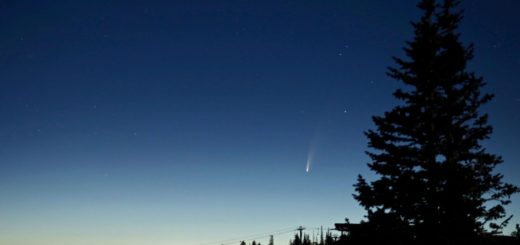Two New NASA/ESA Missions Will Approach Sun To Uncover Some Great Secrets
Two new missions will soon help us uncover the complexities of solar activity in our own solar system and shedding light on the very nature of space and stars throughout the universe.
There are many questions about the complex activity of our Sun.

The NASA/ESA Solar Orbiter will capture the very first images of the Sun’s polar regions, where magnetic tension builds up and releases in a lively dance. Launching in 2020, Solar Orbiter’s study of the Sun will shed light on its magnetic structure and the many forces that shape solar activity. Credits: Spacecraft: ESA/ATG medialab; Sun: NASA/SDO/P. Testa (CfA)
Sun is important for life on Earth but its energy also triggers space weather events that can pose hazard to technology we increasingly depend upon. Such space weather can disrupt radio communications, affect satellites and human spaceflight, and — at its worst — interfere with power grids.
It’s important to better understand of the fundamental processes at the Sun driving these events could improve predictions of when they’ll occur and how their effects may be felt on Earth.
“Our goal is to understand how the Sun works and how it affects the space environment to the point of predictability,” said Chris St. Cyr, Solar Orbiter project scientist at NASA’s Goddard Space Flight Center in Greenbelt, Maryland. “This is really a curiosity-driven science.”
Together, NASA’s Parker Solar Probe and ESA’s (the European Space Agency) Solar Orbiter may resolve decades-old questions about the inner workings of our nearest star.
Parker Solar Probe is slated to launch in the summer of 2018, and Solar Orbiter is scheduled to follow in 2020.
Studying the solar corona
Both missions will take a closer look at the Sun’s corona. From Earth, the corona is visible only during total solar eclipses, when the Moon blocks the Sun’s most intense light and reveals the outer atmosphere’s wispy, pearly-white structure. But the corona isn’t as delicate as it looks during a total solar eclipse — much of the corona’s behavior is unpredictable and not well understood.
Especially two mysteries of the Sun’s corona, are very interesting and important to solve.
What makes the corona so much hotter than the solar surface, and what drives the constant outpouring of solar material, the solar wind, to such high speeds.
“Parker Solar Probe and Solar Orbiter employ different sorts of technology, but — as missions — they’ll be complementary,” said Eric Christian, a research scientist on the Parker Solar Probe mission at NASA Goddard..
“They’ll be taking pictures of the Sun’s corona at the same time, and they’ll be seeing some of the same structures — what’s happening at the poles of the Sun and what those same structures look like at the equator.”
Parker Solar Probe will traverse entirely new territory as it gets closer to the Sun than any spacecraft has come before — as close as 3.8 million miles from the solar surface.
If Earth were scaled down to sit at one end of a football field, and the Sun at the other, the mission would make it to the 4-yard line. The current record holder, Helios B, a solar mission of the late 1970s, made it only to the 29-yard line.
Parker Solar Probe’s four suites of scientific instruments are designed to image the solar wind and study magnetic fields, plasma and energetic particles — clarifying the true anatomy of the Sun’s outer atmosphere. This information will shed light on the so-called coronal heating problem.
Solar Orbiter will come within 26 million miles of the Sun — that would put it within the 27-yard line on that metaphorical football field. It will be in a highly tilted orbit that can provide our first-ever direct images of the Sun’s poles — parts of the Sun that we don’t yet understand well, and which may hold the key to understanding what drives our star’s constant activity and eruptions.
Both Parker Solar Probe and Solar Orbiter will study the Sun’s most pervasive influence on the solar system: the solar wind.
The Sun constantly exhales a stream of magnetized gas that fills the inner solar system, called solar wind.
This solar wind interacts with magnetic fields, atmospheres, or even surfaces of worlds throughout the solar system. On Earth, this interaction can spark auroras and sometimes disrupt communications systems and power grids.
“There are questions that have been bugging us for a long time,” said Adam Szabo, mission scientist for Parker Solar Probe at NASA Goddard.
“We are trying to decipher what happens near the Sun, and the obvious solution is to just go there. We cannot wait — not just me, but the whole community.”



 Creators of mankind
Creators of mankind Description of “Tall white aliens”
Description of “Tall white aliens” Where they came from?
Where they came from? About hostile civilizations
About hostile civilizations The war for the Earth
The war for the Earth “Tall white aliens” about eternal life
“Tall white aliens” about eternal life Video: “Nordic aliens”
Video: “Nordic aliens” Aliens
Aliens Alien encounters
Alien encounters The aliens base
The aliens base UFO
UFO Technology UFO
Technology UFO Underground civilization
Underground civilization Ancient alien artifacts
Ancient alien artifacts Military and UFO
Military and UFO Mysteries and hypotheses
Mysteries and hypotheses Scientific facts
Scientific facts


















